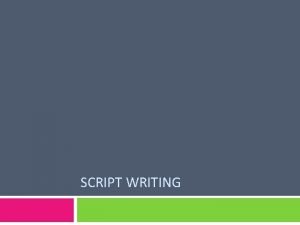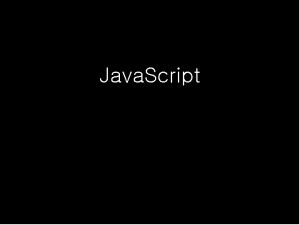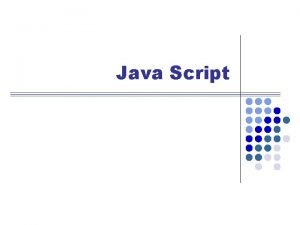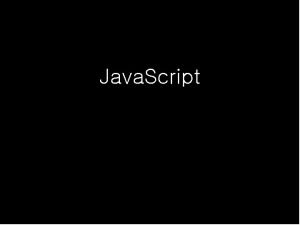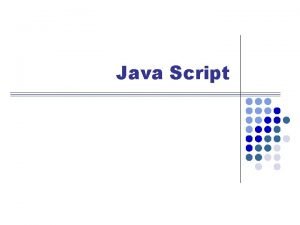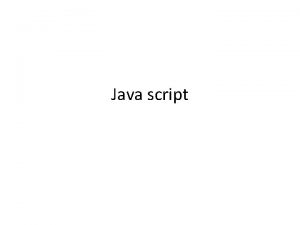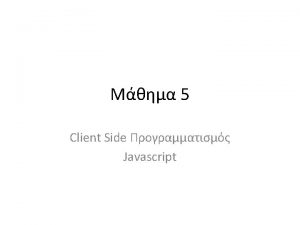What is a Script The Script The script



























- Slides: 27

What is a Script?

The Script The script is the start of making a film. It is the dialogue (what actors say) and direction for the talent (actors), director, and crew. The script will make or break your chances for a good grade and a great film.

The Plot Clearly write out your concept in a couple of lines. Figure out if the story will be a comedy, a drama or a horror story. This is called the “genre” of the film. Decide on your characters and your plot. › The Plot is what happens in the story and in what order

How to Write a Script-Story Structure

Balance-Imbalance-Balance Traditional “Hollywood” script plot is called the three-act structure. (Balance-Imbalance-Balance) Act 1 -Balance (first 30 mins) › › The initial state of your main character. The Who, What, Where, When and Why (Exposition) Rising Action, Setting up the Conflict End of Act 1 is the Inciting Action (Conflict) Act 2 -Imbalance (next 30 -90 mins) › The challenge or obstacle is placed onto our hero which she undertakes to do something about. › The journey that takes place, the MEAT of the story. Act 3 -Balance (last 30 mins) › Things are restored back to order but with something gained. (Resolution) › Our hero has learned something, she has developed.

Central Character There is almost always a central character in a Hollywood movie. Characters are expected to be three dimensional and rounded. Create back-stories for your characters, histories for your characters so they become real. We will also work on this through dialogue.

Character Development Nothing is more important. You can have a weak story or plot, but if your characters really stand out, you will sell your script and/or your film.

Creating Characters Get an idea from observation or experience Create a broad sketch of the character Find the core of the character. What’s important to this Character?

Creating Characters Add emotions, attitudes and values to round out the character. Add details to make the character unique Create character back story

Character Sketch A character sketch, helps you develop your character fully. You want the reader to have a strong mental image of the person, to know how the person talks, to know the person's characteristic ways of doing things, to know something about the person's value system.

Consider the Following Physical Traits Sex Age Height and Weight Color of hair, eyes, skin Posture Appearance (Good looking, obese, lean, pleasant) Defects Heredity

Social Traits Class (lower, upper, middle) Occupation (type of work, attitude towards work, income) Education (type of school, level of education) Life at home (parents, siblings, earning power, parents separated, divorced, character’s marital status, children) Religion Race, Nationality Place in community (head of a club, respected, wanted) Political affiliations

Psychological Traits Moral standards Ambitions, Frustrations, disappointments Temperament (easygoing, pessimistic) Attitude towards life (resigned, militant) Complexes (obsessions, inhibitions, superstitions, phobias) Extrovert, introvert Abilities (languages, talents) Qualities I. Q.

Two Different Styles Bullet Style Paragraph

Jack Rose (Bullet Style)

Jack Rose (Paragraph Style)

Write a Character Sketch Using our main character Ris lets write a list style character sketch. Here is our film concept "This movie is about “Ris, a happy dog trainer whose life is thrown into disarray when her faithful doggy companion Shoop is abducted by a rival dog training company. "

Choose a photo of a person from a magazine or online, someone you know nothing about and write a character sketch about that person. (See Worksheet for Details on what to include)

Step 2 Turn Step 1 into a 4 – 5 sentence paragraph outlining your plot. Make sure you include your main characters and important events. This is basically a short synopsis or overview of your story. This will go on your cover sheet for each film project.

Scriptwriting (AFI's Lights, Camera, Education!)

Title Page There is a very specific way to make a title page. Don’t add pictures, use colored paper or anything of the sort. • Nothing brands you an amateur faster than doing this. Your script will go straight into the trash. • The Best Film Ever by Bill Walters January 19, 2010

Four Main Parts of the Final Script Scene Heading/Setting Description/Action Character Dialogue

Slug Line Scene-Step 6 Are we inside or outside? › EXT or INT Where are we? › Location What time of day is it? › Specific

Description/Action What is the viewer seeing onscreen? Be as descriptive as possible without being too wordy. Steps 3 -5

Character Always Capitalized Consistent in character name

Dialogue-Step 7 This is what the actors say. Follows below the character to say it in script. Less is more, show it visually. If parentheticals () follow then they are to descript how actors should say line or give actors specific instructions.

The Script A page of finished script equals roughly a minute of screen time. You should use Courier (or New Courier) Size 12. This is a fixed-width font, which many believe makes it easier to read. A full length script for a feature film should fall between 90 to 120 pages.
 ưu thế lai là gì
ưu thế lai là gì Thẻ vin
Thẻ vin Cái miệng nó xinh thế
Cái miệng nó xinh thế Các châu lục và đại dương trên thế giới
Các châu lục và đại dương trên thế giới Bổ thể
Bổ thể Từ ngữ thể hiện lòng nhân hậu
Từ ngữ thể hiện lòng nhân hậu Tư thế ngồi viết
Tư thế ngồi viết V cc cc
V cc cc Phép trừ bù
Phép trừ bù Thể thơ truyền thống
Thể thơ truyền thống Chúa sống lại
Chúa sống lại Sự nuôi và dạy con của hổ
Sự nuôi và dạy con của hổ Diễn thế sinh thái là
Diễn thế sinh thái là đại từ thay thế
đại từ thay thế Vẽ hình chiếu vuông góc của vật thể sau
Vẽ hình chiếu vuông góc của vật thể sau Công thức tiính động năng
Công thức tiính động năng Tỉ lệ cơ thể trẻ em
Tỉ lệ cơ thể trẻ em Thế nào là mạng điện lắp đặt kiểu nổi
Thế nào là mạng điện lắp đặt kiểu nổi Lời thề hippocrates
Lời thề hippocrates Vẽ hình chiếu đứng bằng cạnh của vật thể
Vẽ hình chiếu đứng bằng cạnh của vật thể Phản ứng thế ankan
Phản ứng thế ankan Quá trình desamine hóa có thể tạo ra
Quá trình desamine hóa có thể tạo ra Các môn thể thao bắt đầu bằng tiếng nhảy
Các môn thể thao bắt đầu bằng tiếng nhảy Hát kết hợp bộ gõ cơ thể
Hát kết hợp bộ gõ cơ thể Sự nuôi và dạy con của hươu
Sự nuôi và dạy con của hươu điện thế nghỉ
điện thế nghỉ Các loại đột biến cấu trúc nhiễm sắc thể
Các loại đột biến cấu trúc nhiễm sắc thể Biện pháp chống mỏi cơ
Biện pháp chống mỏi cơ





























